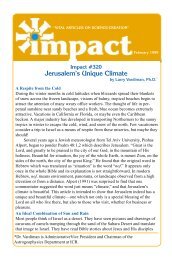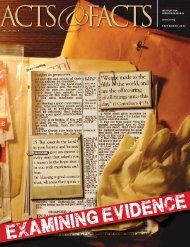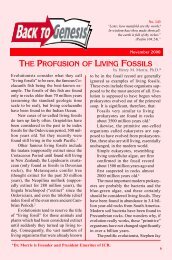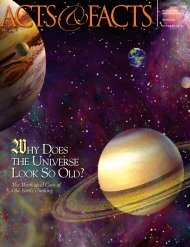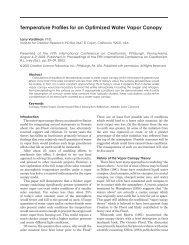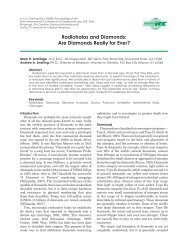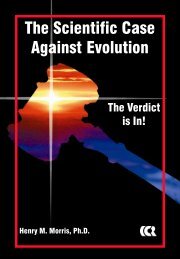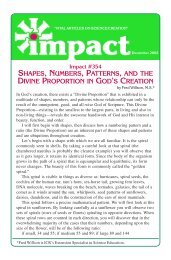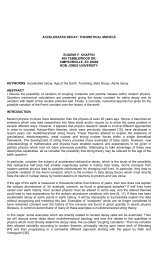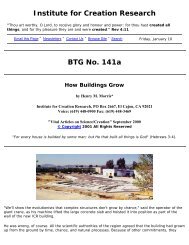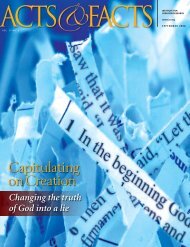The Cosmological Beliefs of the Indians PDF - Institute for Creation ...
The Cosmological Beliefs of the Indians PDF - Institute for Creation ...
The Cosmological Beliefs of the Indians PDF - Institute for Creation ...
You also want an ePaper? Increase the reach of your titles
YUMPU automatically turns print PDFs into web optimized ePapers that Google loves.
“VITAL ARTICLES ON SCIENCE/CREATION”March 2004Impact #369AMERICAN GENESIS<strong>The</strong> <strong>Cosmological</strong> <strong>Beliefs</strong> <strong>of</strong> <strong>the</strong> <strong>Indians</strong>by Bill Johnson*With <strong>the</strong> rise <strong>of</strong> uni<strong>for</strong>mitarian geology and Darwinian evolution in <strong>the</strong>nineteenth century, <strong>the</strong> stage was set <strong>for</strong> a naturalistic interpretation <strong>of</strong> life.Naturalism would soon pervade every facet <strong>of</strong> life (biology, sociology,<strong>the</strong>ology, etc.). <strong>The</strong> “higher” critics applied this philosophy to <strong>the</strong> Bible in<strong>the</strong>ir quest to strip it <strong>of</strong> <strong>the</strong> supernatural. Events in <strong>the</strong> book <strong>of</strong> Genesis suchas <strong>the</strong> creation <strong>of</strong> man, original sin, <strong>the</strong> worldwide flood, and <strong>the</strong> Tower <strong>of</strong>Babel, were written <strong>of</strong>f as mythological. One anti-creationist boldly stated,“Nearly all peoples have developed <strong>the</strong>ir own creation myth, and <strong>the</strong> Genesisstory is just <strong>the</strong> one that happened to have been adopted by one particulartribe <strong>of</strong> Middle Eastern herders.” 1 It is commonplace today to view <strong>the</strong> book<strong>of</strong> Genesis, as well as <strong>the</strong> whole Bible, through <strong>the</strong> spectacles <strong>of</strong> naturalism.Despite <strong>the</strong> widespread acceptance <strong>of</strong> this philosophy, anthropology hasyielded strong evidence in favor <strong>of</strong> <strong>the</strong> miraculous events recorded in Genesis.Nearly all people <strong>of</strong> <strong>the</strong> world, including <strong>the</strong> American <strong>Indians</strong>, have cosmologicalbeliefs that are similar to <strong>the</strong> Genesis account. Although grossexaggerations have worked <strong>the</strong>ir way into <strong>the</strong>ir stories through thousands <strong>of</strong>years <strong>of</strong> retelling <strong>the</strong> tales, it is evident that <strong>the</strong> main points in <strong>the</strong> Genesisaccount (chapters 1–11) have been preserved.<strong>Creation</strong> <strong>of</strong> Mankind“. . . <strong>the</strong> LORD God <strong>for</strong>med man <strong>of</strong> <strong>the</strong> dust <strong>of</strong> <strong>the</strong> ground, and brea<strong>the</strong>d intohis nostrils <strong>the</strong> breath <strong>of</strong> life. . . . <strong>the</strong> LORD God caused a deep sleep to fallupon Adam, and he slept: and He took one <strong>of</strong> his ribs . . . made . . . a woman,and brought her unto <strong>the</strong> man” (2:7,21–22).<strong>The</strong> question <strong>of</strong> man’s origin has been debated <strong>for</strong> thousands <strong>of</strong> years. Allmen, regardless <strong>of</strong> race or religion (even a<strong>the</strong>ists) have a creation story thataccounts <strong>for</strong> man’s existence. Most Indian tribes attribute this creation to aCreator, and <strong>the</strong>ir stories show great similarities to <strong>the</strong> creation story outlinedin <strong>the</strong> book <strong>of</strong> Genesis.*Bill Johnson is a creationist from Spokane, Washington.
<strong>The</strong> Salinan <strong>Indians</strong> <strong>of</strong> sou<strong>the</strong>rn Cali<strong>for</strong>nia say: “When <strong>the</strong> world was finished,<strong>the</strong>re were as yet no people, but <strong>the</strong> Bald Eagle was <strong>the</strong> chief <strong>of</strong> <strong>the</strong> animals. He sawthat <strong>the</strong> world was incomplete and decided to make some human beings. So he tooksome clay and modelled <strong>the</strong> figure <strong>of</strong> a man and laid him on <strong>the</strong> ground. At first hewas very small but grew rapidly until he reached normal size. But as yet he had nolife; he was still asleep. <strong>The</strong>n <strong>the</strong> Bald Eagle stood and admired his work. ‘It isimpossible,’ said he, ‘that he should be left alone; he must have a mate.’ So he pulledout a fea<strong>the</strong>r and laid it beside <strong>the</strong> sleeping man. <strong>The</strong>n he left <strong>the</strong>m and went <strong>of</strong>f ashort distance, <strong>for</strong> he knew that a woman was being <strong>for</strong>med from <strong>the</strong> fea<strong>the</strong>r. But <strong>the</strong>man was still asleep and did not know what was happening. When <strong>the</strong> Bald Eagledecided that <strong>the</strong> woman was about completed, he returned, awoke <strong>the</strong> man byflapping his wings over him and flew away.” 2<strong>The</strong> Pima <strong>Indians</strong> <strong>of</strong> sou<strong>the</strong>rn Arizona believe, “Earth Maker took some clay inhis hands, mixed it with his own sweat, and <strong>for</strong>med it into two figures—a man and awoman. He brea<strong>the</strong>d life into <strong>the</strong>m and <strong>the</strong>y began to walk around. <strong>The</strong>y lived. <strong>The</strong>yhad children. <strong>The</strong>y peopled <strong>the</strong> land. <strong>The</strong>y built villages.” 3Original Sin“. . . <strong>the</strong> LORD God commanded . . . <strong>of</strong> <strong>the</strong> tree <strong>of</strong> <strong>the</strong> knowledge <strong>of</strong> good and evil,thou shall not eat . . . in <strong>the</strong> day that thou eatest <strong>the</strong>re<strong>of</strong> thou shalt surely die. . . . <strong>the</strong>woman . . . took <strong>of</strong> <strong>the</strong> fruit <strong>the</strong>re<strong>of</strong>, and did eat . . . her husband [also] did eat.. . . [<strong>the</strong> Lord said] . . . cursed is <strong>the</strong> ground <strong>for</strong> thy sake . . . <strong>for</strong> out <strong>of</strong> it wast thoutaken: <strong>for</strong> dust thou art, and unto dust shalt thou return” (2:16–17; 3:6,17,19).While <strong>the</strong> idea <strong>of</strong> original sin is not common among all Indian tribes, some, like<strong>the</strong> Incas <strong>of</strong> Peru, record <strong>the</strong> story in great detail:“<strong>The</strong> natives <strong>of</strong> this land affirm that in <strong>the</strong> beginning, and be<strong>for</strong>e this world wascreated, <strong>the</strong>re was a being called Viracocha. . . . when he had created <strong>the</strong> world he<strong>for</strong>med a race <strong>of</strong> giants <strong>of</strong> disproportioned greatness painted and sculptured, to seewhe<strong>the</strong>r it would be well to make real men <strong>of</strong> that size. He <strong>the</strong>n created men in hislikeness as <strong>the</strong>y are now; and <strong>the</strong>y lived in darkness.Viracocha ordered <strong>the</strong>se people that <strong>the</strong>y should live without quarrelling, andthat <strong>the</strong>y should know and serve him. He gave <strong>the</strong>m a certain precept which <strong>the</strong>ywere to observe on pain <strong>of</strong> being confounded if <strong>the</strong>y should break it. <strong>The</strong>y keptthis precept <strong>for</strong> some time, but it is not mentioned what it was. But as <strong>the</strong>re aroseamong <strong>the</strong>m <strong>the</strong> vices <strong>of</strong> pride and covetousness, <strong>the</strong>y transgressed <strong>the</strong> precept <strong>of</strong>Viracocha Pachayachachi and falling, through this sin, under his indignation, heconfounded and cursed <strong>the</strong>m.” 4Flood“. . . <strong>the</strong> wickedness <strong>of</strong> man was great in <strong>the</strong> earth. . . . <strong>the</strong> LORD said, I will destroy. . . both man, and beast . . . and [He said to Noah] Make <strong>the</strong>e an ark. . . . I willcause it to rain upon <strong>the</strong> earth. . . . <strong>the</strong> waters prevail[ed]. . . . and <strong>the</strong> mountainswere covered. . . . every living substance was destroyed . . . and Noah only remainedalive, and <strong>the</strong>y that were with him . . .” (6:5,7,14; 7:4,20,23).<strong>The</strong>re is no o<strong>the</strong>r story among <strong>the</strong> <strong>Indians</strong> as prolific as <strong>the</strong> worldwide flood.Nearly every tribe has a flood story that is similar to <strong>the</strong> Genesis flood. 5 <strong>The</strong>Tehuelche <strong>of</strong> Patagonia attribute <strong>the</strong> flood to <strong>the</strong> wickedness <strong>of</strong> man:ii
“At a remote time in <strong>the</strong> past, <strong>the</strong> earth was inhabited also by people o<strong>the</strong>r thanthose created by <strong>the</strong> sun-god. <strong>The</strong>y were very bad and fought among <strong>the</strong>mselves all<strong>the</strong> time. When <strong>the</strong> sun-god saw this he decided to annihilate <strong>the</strong>se people and tocreate ano<strong>the</strong>r population in <strong>the</strong>ir stead. To destroy <strong>the</strong> bad people, <strong>the</strong> sun-god senttorrential and continuous rain, <strong>the</strong> springs opened, and <strong>the</strong> ocean overflowed. In <strong>the</strong>deluge all mankind and all animals were swept away. . . . <strong>the</strong> sun-god sent [out] <strong>the</strong>dove, which returned with blades <strong>of</strong> grass in its beak, proving <strong>the</strong>reby that it hadfound dry land. <strong>The</strong>n <strong>the</strong> sun-god decided to create new people. First he made aman, <strong>the</strong>n a woman, and finally a dog to keep <strong>the</strong>m company.” 6<strong>The</strong> Lillooet <strong>of</strong> British Columbia believe that one day a great and continuous rainflooded <strong>the</strong> world. <strong>The</strong> Lillooet Noah, Ntci’nemkin, took refuge with his family in alarge canoe. <strong>The</strong> o<strong>the</strong>rs ascended to <strong>the</strong> mountaintops but <strong>the</strong> flood soon covered<strong>the</strong>m. Only <strong>the</strong> peak <strong>of</strong> Split Mountain remained uncovered. As <strong>the</strong> waters receded,<strong>the</strong> canoe rested on Smimelc Mountain. When <strong>the</strong> ground was dry <strong>the</strong> peopledescended and repopulated <strong>the</strong> earth. 7Tower <strong>of</strong> Babel“. . . <strong>the</strong> whole earth was <strong>of</strong> one language, and <strong>of</strong> one speech. . . . And <strong>the</strong>y said, Go. . . let us build us a city and a tower, whose top may reach unto heaven. . . . <strong>the</strong>LORD said. . . . let us go down, and <strong>the</strong>re confound <strong>the</strong>ir language. . . . So <strong>the</strong> LORDscattered <strong>the</strong>m abroad . . . and <strong>the</strong>y [ceased] to build <strong>the</strong> city” (11:1,4,6–8).Unlike <strong>the</strong> proliferation <strong>of</strong> flood legends, those concerning <strong>the</strong> confusion <strong>of</strong>tongues are mostly confined to <strong>the</strong> tribes <strong>of</strong> <strong>the</strong> sou<strong>the</strong>rn states and Mexico. Moststories are only brief allusions, usually tacked on to <strong>the</strong> end <strong>of</strong> a flood legend, butsome tribes, like <strong>the</strong> Choctaw <strong>of</strong> Louisiana, have preserved a detailed account:“Many generations ago Aba, <strong>the</strong> good spirit above, created many men, allChoctaw, who spoke <strong>the</strong> language <strong>of</strong> <strong>the</strong> Choctaw, and understood one ano<strong>the</strong>r.<strong>The</strong>se came from <strong>the</strong> bosom <strong>of</strong> <strong>the</strong> earth, being <strong>for</strong>med <strong>of</strong> yellow clay, and no menhad ever lived be<strong>for</strong>e <strong>the</strong>m. One day all came toge<strong>the</strong>r and, looking upward,wondered what <strong>the</strong> clouds and <strong>the</strong> blue expanse above might be. <strong>The</strong>y continuedto wonder and talk among <strong>the</strong>mselves and at last determined to endeavor to reach<strong>the</strong> sky. So <strong>the</strong>y brought many rocks and began building a mound that was to havetouched <strong>the</strong> heavens. That night, however, <strong>the</strong> wind blew strong from above and<strong>the</strong> rocks fell from <strong>the</strong> mound. . . . <strong>The</strong> men were not killed, but when daylightcame and <strong>the</strong>y made <strong>the</strong>ir way from beneath <strong>the</strong> rocks and began to speak to oneano<strong>the</strong>r, all were astounded as well as alarmed—<strong>the</strong>y spoke various languages andcould not understand one ano<strong>the</strong>r. Some continued <strong>the</strong>nce<strong>for</strong>ward to speak <strong>the</strong>original tongue, <strong>the</strong> language <strong>of</strong> <strong>the</strong> Choctaw, and from <strong>the</strong>se sprung <strong>the</strong> Choctawtribe. <strong>The</strong> o<strong>the</strong>rs, who could not understand this language, began to fight among<strong>the</strong>mselves. Finally <strong>the</strong>y separated. <strong>The</strong> Choctaw remained <strong>the</strong> original people; <strong>the</strong>o<strong>the</strong>rs scattered, some going north, some east, and o<strong>the</strong>rs west, and <strong>for</strong>medvarious tribes. This explains why <strong>the</strong>re are so many tribes throughout <strong>the</strong> countryat <strong>the</strong> present time.” 8<strong>The</strong> Anahuac <strong>Indians</strong> <strong>of</strong> Mexico believe that after <strong>the</strong> flood, <strong>the</strong> survivors beganbuilding a vast pyramid <strong>of</strong> bricks to reach <strong>the</strong> heavens. This angered <strong>the</strong> gods, whodestroyed <strong>the</strong> pyramid by sending down fire from heaven. 9iii
ConclusionWhat are we to make <strong>of</strong> all <strong>the</strong>se similarities? Does <strong>the</strong> evidence point to a commonsource? Is <strong>the</strong>re a reasonable alternative?Those persuaded by naturalism believe <strong>the</strong>se stories are widespread because <strong>the</strong><strong>Indians</strong> learned <strong>the</strong>m from missionaries. <strong>The</strong>re are several reasons why this explanationfails. (1) <strong>The</strong> first missionaries recorded some <strong>of</strong> <strong>the</strong>se stories. (2) <strong>The</strong> <strong>Indians</strong><strong>of</strong>ten distinguish between <strong>the</strong> traditions <strong>of</strong> <strong>the</strong>ir ancestors and those <strong>of</strong> <strong>the</strong> whiteman. (3) <strong>The</strong> heart <strong>of</strong> <strong>the</strong> Christian message is Christ, who is non-existent in Indianmythology, and (4) great exaggerations speak <strong>of</strong> long ages, which would predatemissions to <strong>the</strong> American continents.<strong>The</strong> most reasonable explanation <strong>for</strong> <strong>the</strong> similarities between <strong>the</strong> stories containedin American Indian folklore, and those recorded in <strong>the</strong> book <strong>of</strong> Genesis, isthat all people are descendents <strong>of</strong> Noah’s family. After <strong>the</strong> flood, mankind multipliedonce more; and <strong>the</strong>se stories were fresh in <strong>the</strong> minds <strong>of</strong> men who would soonbe dispersed throughout <strong>the</strong> whole world.Despite <strong>the</strong> failures <strong>of</strong> naturalism, this worldview continues to hold <strong>the</strong> minds <strong>of</strong>countless individuals. One might wonder why <strong>the</strong>re is such a strong propensitytowards a naturalistic interpretation <strong>of</strong> life. <strong>The</strong> main reason lies with <strong>the</strong> religiousand ethical implications supernaturalism has on man. (cf. John 3:19–20.)Naturalists would claim to reject supernaturalism on scientific grounds alone.<strong>The</strong> truth is that naturalism cannot account <strong>for</strong> <strong>the</strong> known facts. It isn’t drivenscientifically, but is a philosophical position that has excluded <strong>the</strong> supernatural. Anhonest evaluation <strong>of</strong> all <strong>the</strong> data, especially <strong>the</strong> anthropological evidence, shouldlead one to <strong>the</strong> conclusion that supernaturalism is <strong>the</strong> position that fits <strong>the</strong> factsbetter than its rivals.Endnotes1. Dawkins, Richard, Blind Watchmaker, New York, Norton, 1986, p. 316.2. Mason, J. Alden, “<strong>The</strong> Ethnology <strong>of</strong> <strong>the</strong> Salinan <strong>Indians</strong>” in University <strong>of</strong>Cali<strong>for</strong>nia Publications in American Archaeology and Ethnology, vol. 10,no. 4, 14 Dec. 1912, pp. 191–192.3. Erdoes, Richard, American Indian Myths and Legends, New York, Pan<strong>the</strong>onBooks, 1984, pg. 473.4. Markham, Sir Clements, History <strong>of</strong> <strong>the</strong> Incas, 1967, pp. 28–29.5. <strong>The</strong> author has amassed over 200 flood legends from North and South America.6. Wilbert, Johannes and Karin Simoneau, Folk Literature <strong>of</strong> <strong>the</strong> Tehuelche<strong>Indians</strong>, UCLA, 1984, p. 104.7. Teit, James, “Traditions <strong>of</strong> <strong>the</strong> Lillooet <strong>Indians</strong> <strong>of</strong> British Columbia” in <strong>The</strong>Journal <strong>of</strong> American Folklore, vol. XXV, No. XCVIII, 1912, p. 342.8. Bushnell, David L., “<strong>The</strong> Choctaw <strong>of</strong> Bayou Lacomb St. Tammany ParishLouisiana” in Bulletin <strong>of</strong> <strong>the</strong> Bureau <strong>of</strong> American Ethnology, vol. 48, 1909,p. 30.9. Tylor, Edward B., Anahuac: Or Mexico and <strong>the</strong> Mexicans, Ancient and Modern,London, Longman & Roberts, 1861, pp. 276– 277.iv© 2004 by ICR • All Rights ReservedSingle copies 10¢ • Order from: INSTITUTE FOR CREATION RESEARCHP.O. Box 2667, El Cajon, CA 92021 • Available <strong>for</strong> download on our website (www.icr.org).



